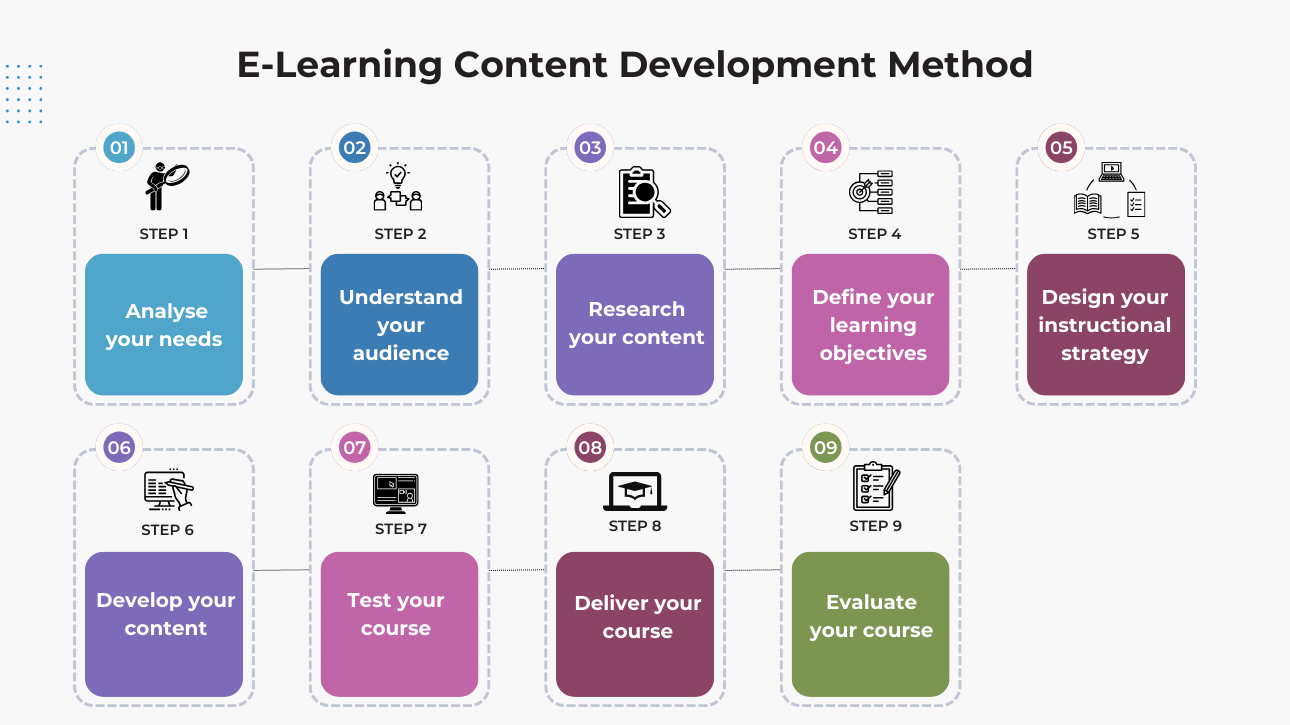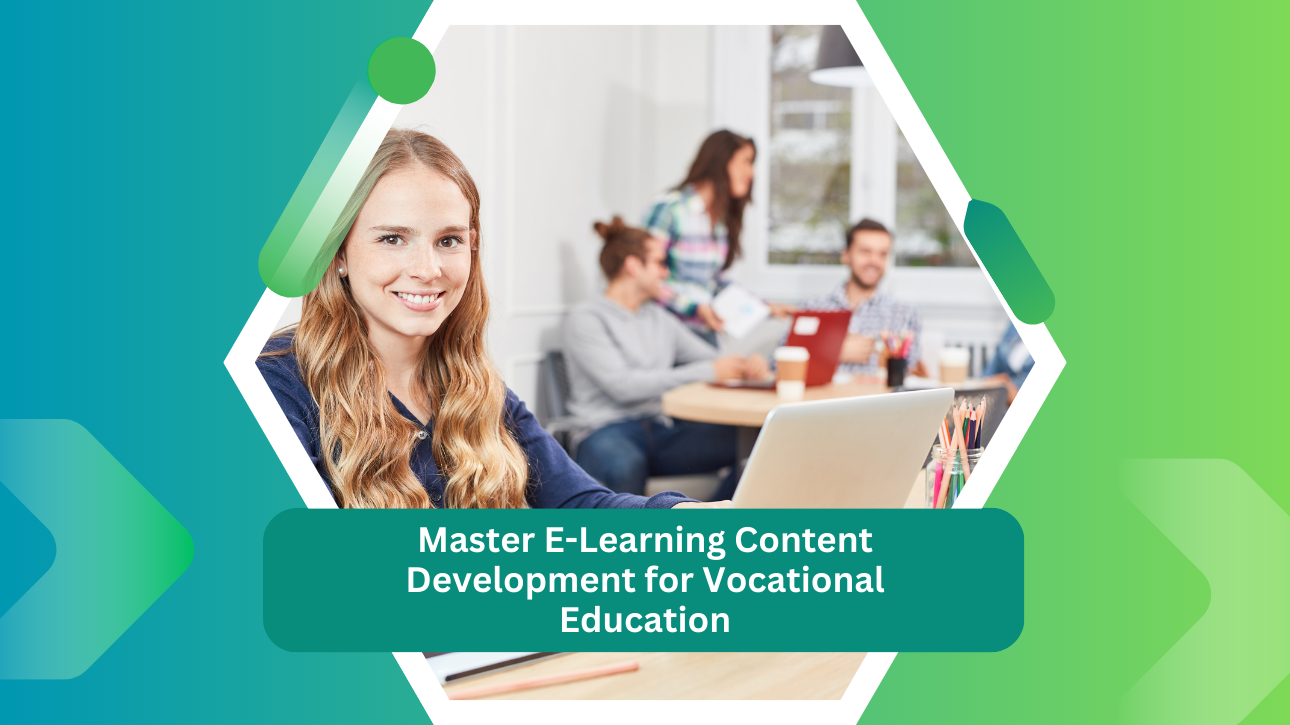E-learning is a rapidly growing field, and vocational education is no exception. RTOs across Australia are increasingly using e-learning to deliver their training programs. This is because e-learning offers several advantages over traditional classroom training, such as flexibility, convenience, interactive virtual classrooms and cost-effectiveness.
However, developing effective e-learning content is not always easy. It requires a deep understanding of the learning process, as well as the specific needs of vocational learners. In this blog post “Master E-Learning Content Development for Vocational Education”, we will provide some tips on how to write effective e-learning content for vocational education.
E-Learning Content Development

Step 1: Analyse your :
It is important to ensure that your e-learning course is relevant and meets the needs of your learners and organisation.
- What skills do your learners need to master to be successful in their jobs?
- What are the specific goals of your e-learning course?
- How will you measure success?
Step 2: Understand your audience:
It is important to create an e-learning course that is engaging and effective for your target learners.
- Who are you creating this course for? What are their demographics, job roles, and prior knowledge of the topic?
- What are their learning styles and needs?
- What are their expectations for your e-learning course?
Step 3: Research your content:
It is important to develop accurate and up-to-date content that is aligned with your learning objectives.
- What information do your learners need to know to achieve your learning objectives?
- What resources are available to you, such as subject matter experts, industry publications, and online courses?
- How can you organise your content in a logical and engaging way?
Step 4: Define your learning objectives:
It is important to show that your e-learning course is focused and that learners know what they are expected to learn.
- What should your learners be able to do by the end of the course?
- Your learning objectives should be specific, measurable, achievable, relevant, and time bound.
Step 5: Design your instructional strategy:
It is necessary to choose the best methods for delivering your content and engaging your learners.
- How will you deliver your content and engage your learners?
- What activities and assessments will you use to promote learning and measure learner progress?
- How will you differentiate instruction for learners with different needs?
Step 6: Develop your :
It is necessary to create engaging and informative content that is aligned with your learning objectives and instructional strategy.
- Create engaging and informative content that is aligned with your learning objectives and instructional strategy.
- Use a variety of media, such as text, images, videos, and animations, to make your content more visually appealing and interactive.
- Ensure that your content is accessible to all learners, regardless of their abilities.
Step 7: Test your course:
This step is important to identify any areas that need improvement before launching your course to a wider audience.
- Pilot-test your course with a small group of learners to identify any areas that need improvement.
- Gather feedback on the content, activities, and assessments.
- Make necessary revisions before launching your course to a wider audience.
Step 8: Deliver your course:
Your eLearning course should be available to your learners and you should also provide them with the support they need to succeed.
- Make your course available to your learners on a learning management system (LMS) or other mediums.
- Provide learners with support and guidance as they complete the course.
- Track learner progress and provide feedback.
Step 9: Evaluate your course:
It is important because feedback from learners can be used to improve your e-learning course in the future.
- Collect feedback from learners to assess the effectiveness of your course.
- Analyse learner performance data to identify areas for improvement.
- Make necessary revisions to future versions of the course.
Tips for E-learning Content Development

- Talk to your learners and fellow trainers of the same qualification and industry experts . What are their needs and expectations for your e-learning content? What are their learning styles and preferences?
- Consider the budget and resources available. How much time and money do you have for the course development process and delivering your e-learning content?
- Your e-learning content should be accessible to all learners, regardless of their abilities, backgrounds, or learning styles.
- Make sure your e-learning content is presented in a way that is easy to follow and understand.
- There are many different ways to deliver e-learning content, such as online courses, videos, simulations, and games.
- Use clear and concise language. Avoid using jargon or technical language that your learners may not understand.
- Track learner progress and provide feedback. This will help you to identify learners who are struggling and provide them with the support they need.
- Collect feedback from learners. This will help you to assess the effectiveness of your course and identify any areas for improvement.
Conclusion
Training content development is a crucial part of creating a meaningful learning experience for different types of learners. By following the steps and tips outlined in this blog post, you can develop effective e-learning content that is engaging, informative, and aligned with your learning objectives.
Are you an RTO looking for quality e-learning resources to provide an excellent online learning experience for your students? Look no further as VET Resources has the best resources for you. We also offer free RTO consultation for RTOs. For more information contact us here.
FAQs
Q.1. What are different types of e-learning content?
Examples of e-content include:
- Online courses and tutorials
- eBooks and audiobooks
- Webinars and podcasts
- Videos and animations
- Interactive simulations and games
- Infographics and presentations
- Online articles and blog posts
- Social media content
- Mobile apps
Q.2. What are the challenges of e-learning?
A.2. Some of the challenges of e-learning include:
- It can be difficult to keep learners engaged in an online environment.
- Not everyone has access to the technology or resources they need to participate in e-learning.
- It can be difficult for learners to stay motivated to complete e-learning courses on their own time.
- It can be difficult to assess learner progress and achievement in an online environment.
Q.3. What are the considerations of e-learning?
A.3. When developing or delivering e-learning, it is important to consider the following factors:
- Target audience: Who are you creating the e-learning for? What are their needs and learning styles?
- Learning objectives: What do you want learners to be able to do by the end of the e-learning experience?
- Instructional design: How will you deliver the content and engage learners?
- Technology: What technology will learners need to access the e-learning?
- Assessment: How will you assess learner progress and achievement?
Q.4. What are the benefits of e-learning?
A.4. Benefits of e-learning:
- Convenience: Learners can access e-learning content from anywhere, at any time.
- Flexibility: Learners can learn at their own pace and on their own schedule.
- Affordability: A good online course is often more affordable than traditional classroom training.
- Scalability: E-learning can be easily scaled up or down to meet the needs of different learner populations.
- Engagement: E-learning can be more engaging than traditional classroom training, especially when it uses a variety of media and interactive activities.
Q.5 What is the type of tone and tone of voice that should be used in eLearning content?
A.5. The type of tone and tone of voice that should be used in eLearning content will vary depending on the audience and the learning objectives. However, in general, it is important to use a tone that is friendly, engaging, and informative. The tone of voice should also be appropriate for the level of the learners. For example, if you are creating eLearning content for adult learners, you can use a more formal tone. However, if you are creating eLearning content for children, you may want to use a more informal tone.
Q.6 What is the content writing process for creating a custom e-learning course?
A.6. To answer your question in brief, here is a summary of the content writing process for creating a custom eLearning course:
- Analyse your needs and audience.
- Research your content.
- Organise your content.
- Write your content.
- Edit and proofread your content.
- Test your content.
- Revise your content.
- Finalise your content
Suggested Read: Why do RTOs need to understand SCORM files to deliver e-learning courses
Disclaimer:
The information presented on the VET Resources blog is for general guidance only. While we strive for accuracy, we cannot guarantee the completeness or timeliness of the information. VET Resources is not responsible for any errors or omissions, or for the results obtained from the use of this information. Always consult a professional for advice tailored to your circumstances.






